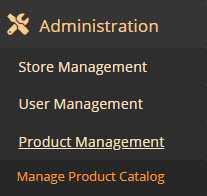Catalog Management
Topics:
Publish catalog to other stores
![]() Note: The recommended size of the inventory data for easier maintenance is 1500 active items per store.
Note: The recommended size of the inventory data for easier maintenance is 1500 active items per store.
The catalog management guide includes:
- Catalog Categories Management
- Manage Catalog (Physical Goods and Digital Goods or Services)
- Serial and Non-Serial Products
- Service Plans
- Catalog Publishing
- Product Features
- Custom Labels
- Custom Attributes
- Advanced Promotions
- Best Selling & Featured Products Management
- Related Items
- Custom Taxes by Category
- Discount approval by Category
The Inventory Catalog Manager opens from: Navigation menu > Administration > Product Management > Manage Product Catalog.

Description
The Inventory Catalog Management screen enables viewing the main inventory catalog, creating new products, editing, and retiring products, setting SKUs, descriptions, related items, prices, and other properties for each product.
The Catalog Management screen has two linked utilities: the Product Management utility, and the Catalog Export utility which enables exporting catalog updates to all stores and regions or to a group of stores and regions.
![]() Note: The system provides a backend file-based Interface to import new products and update existing product listings.
Note: The system provides a backend file-based Interface to import new products and update existing product listings.
Access to the Catalog Management feature is based on security permissions.
![]() Note: The following screenshots contain dummy data only. Reference data (such as inventory categories and statuses) that is shown in the screenshots is for demonstration purposes only.
Note: The following screenshots contain dummy data only. Reference data (such as inventory categories and statuses) that is shown in the screenshots is for demonstration purposes only.
The catalog item’s properties are loaded by selecting an item from the search pane.
The properties page enables setting the item SKU, item description, categories, Manufacturer’s Suggested Retail Price (MSRP), default price (the price before discount), and a minimum price (lowest price without requiring a manager override), as well as the serial number requirements. There is an On/Off button that determines whether an item is serialized.
![]() Note: Prices and Items can be set up in a third party product catalog, and can be synchronized into the MT-POS catalog via interface extract.
Note: Prices and Items can be set up in a third party product catalog, and can be synchronized into the MT-POS catalog via interface extract.
Where the business has multiple stores, product properties are updated at the main location, and then the definition in all locations which have the product defined will also be updated, by using catalog definition export utility. If update to definitions is required in certain locations, the update can be published in those locations only.
When a location needs to receive a product that has not yet been defined in that location, the definition is retrieved from the main location (Master Catalog) automatically. There is no user action required at the store, whether the product definitions were received from a third party or exported via MT-POS export utility.
Controlling taxation:
Taxation of Over-the-Counter sales in MT-POS is calculated by MT-POS.
Taxation is controlled by:
Product option – taxable or not – set for each product if it is taxable or not:
- Tax will only be added to items which are indicated as taxable.
- Tax will be included in the item price.
- Tax for non-taxable items is 0.
Product category 1:
Tax code is associated with each product category 1.
VAT tax code will be defined and set to all category level 1 that requires VAT tax to be added.
The VAT rate is defined in the database for each store, and can be updated as reference tables update.